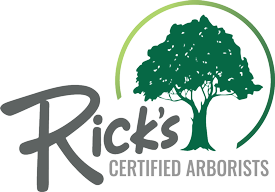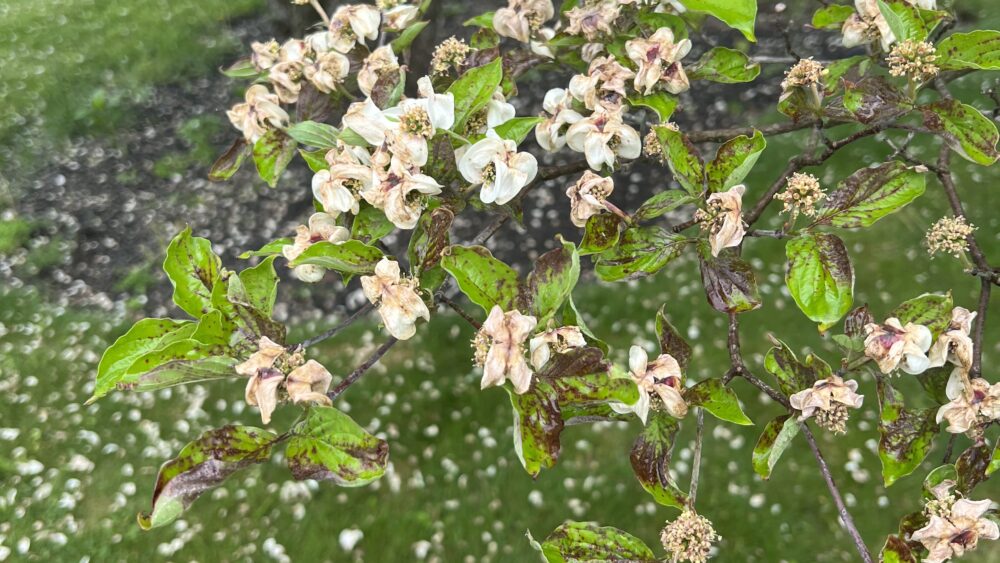Dogwood Anthracnose is a fungal disease caused by Discula destructiva. It causes flowering dogwood trees to experience blighted leaves, reduced flowering, and defoliation in the spring. Call Rick’s PHC Certified Arborists at 610-840-2655 to assess whether your flowering dogwoods have this dangerous disease and how Certified Arborists can treat it.
What Is Dogwood Anthracnose?
Dogwood anthracnose mostly affects Flowering Dogwoods (Cornus florida) and Pacific Dogwoods (Cornus nuttallii). It is a non-native disease that severely damaged populations of local Flowering Dogwood in New England. The native tree has no intrinsic defense against this pathogen. If environmental conditions are ideal, Dogwood Anthracnose can kill a tree.
Symptoms
Some of the symptoms of Dogwood Anthracnose include:
- Leaf Spots: Leaf spots may be blotchy or round. They are usually tan with reddish-purple edges.
- Death of Small Shoots and Succulent Stems: These appendages may die even if the infection does not progress.
- Cankers: Large knots in the bark or branches are known as cankers. These disease markers can disrupt the mineral, nutrient, and water absorption systems. This condition means that the tree’s canopy will die back quickly.
- Damaged Vascular System in the Wood: A telltale sign of damage in the vascular system is if the vascular cambium (also known as the cork cambium or area within the growth rings) appears to be a chocolate brown color instead of a healthy pale tan.
Treatment
To treat Dogwood Anthracnose, Certified Arborists can use fungicide in wet spring weather when the buds open. Pruning should happen as blighted stems and shoots develop. If infected leaves fall, be sure to pick them up promptly.
Prevention
The best prevention for this disease is planting disease-resistant Dogwood varieties: Kousa dogwood (Cornus kousa) and Tatarian Dogwood (C. alba). Redosier dogwood (C. sericea) is another excellent alternative. Hybrids of C. kousa and C. florida can also resist the disease.
Are You a Good Candidate for Dogwood Anthracnose Treatment?
If you have planted valuable Dogwoods that are vulnerable to this disease, you may want to treat them rather than replace them with resistant varieties. Certified Arborists recommend planting resistant varieties if you have Dogwood Anthracnose issues.
Why Choose Rick’s PHC Certified Arborists?
Our company has multiple Certified Arborists who can diagnose your trees’ issues, present treatment options, and save your trees as often as possible. They dedicate themselves to ensuring your home landscape stays beautiful and untouched by common diseases.
Frequently Asked Questions About Dogwood Anthracnose
Here are several customer questions about Dogwood Anthracnose:
Why is Dogwood Anthracnose dangerous?
Dogwood Anthracnose can blight tree foliage almost completely. It creates angular spots and scars on the leaves. It causes cankers that disrupt minerals and water, causing canopy dieback that worsens over time.
Are epicormic sprouts a sign of Dogwood Anthracnose?
Yes, epicormic sprouts could signify that your Dogwood is not doing well. An epicormic sprout is a small-diameter stem that appears within the canopy. The stems mostly appear in the shade, meaning the infection can easily access them. These small stems are highly susceptible to Dogwood Anthracnose.
What weather conditions lead to Dogwood Anthracnose?
Like many fungal tree diseases, Dogwood Anthracnose prefers high moisture, shade, and humidity. These conditions cause the infection to spread and possibly move between trees rapidly. The spores spread due to splashing rainwater.
How should I treat Dogwood Anthracnose?
A professional’s expert treatment usually becomes necessary when Dogwood trees become infected. However, you can take important steps at home to lessen the chances of a severe infestation. First, avoid using a mower or string trimmer near the tree. Cuts in the bark could attract Dogwood Borer insects and other disease vectors. Irrigate the roots in dry times and put 2-3 inches of mulch over the roots.
Does Dogwood Anthracnose affect the ornamental blossoms?
Yes, it can blight the blossoms as well as the leaves. If you want your tree to survive, you should treat it regardless of whether the blossoms are affected.
When should the Certified Arborist treat the tree with fungicide?
If the tree has a known problem with Dogwood Anthracnose, it is best to treat it with fungicide. Applications should start when buds open.
Call Rick’s PHC Certified Arborists
Call Rick’s PHC Certified Arborists at 610-840-2655 if you have noticed that your Dogwood trees are not looking their best. They may have Dogwood Anthracnose, a serious condition that could compromise their health and safety. While this disease is somewhat difficult to treat, you can avoid it by planting resistant Dogwood varieties.


Comments are closed.